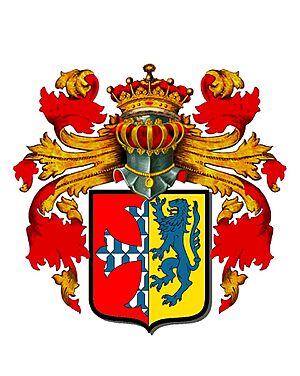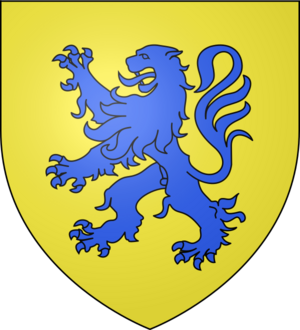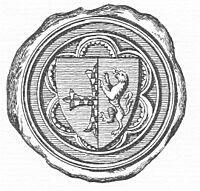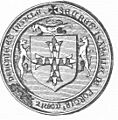Isabel de Forz, 8th Countess of Devon facts for kids
Isabel de Forz (also known as Isabel de Redvers) was born in July 1237. She was the oldest daughter of Baldwin de Redvers, 6th Earl of Devon. When her brother, Baldwin de Redvers, 7th Earl of Devon, died in 1262 without children, Isabel became the Countess of Devon in her own right. She also inherited important lands like the feudal barony of Plympton in Devon and the lordship of the Isle of Wight.
Isabel became one of the wealthiest women in England after her husband and brother died when she was still young. She mostly lived at Carisbrooke Castle on the Isle of Wight, which she held directly from the king.
She had six children, but sadly, all of them passed away before her. Just before she died, she was convinced to sell the Isle of Wight to King Edward I. This sale has been seen as a bit unfair by some historians. Her cousin, Hugh de Courtenay, 1st/9th Earl of Devon, inherited her lands in Plympton.
Countess Wear, a place near Exeter, is named after a weir (a small dam) that Isabel built on the River Exe. Many interesting stories and legends are also told about her.
Contents
Early Life and Family
Isabel was the oldest daughter of Baldwin de Redvers, 6th Earl of Devon, who lived at Tiverton Castle in Devon. Her mother was Amice de Clare. Isabel likely spent her early years at Tidcombe, close to her father's home.
Marriage and Children
When Isabel was about 11 or 12, she married William de Forz, 4th Earl of Albemarle. He owned land in Yorkshire and Cumberland and was also a Count in Normandy, France. When William died in 1260, their children were still young. This meant that King Henry III took control of William's lands and the care of his heir.
Isabel received a part of her late husband's lands as her "dower," which was a widow's share of her husband's property. This included parts of Holderness, Cockermouth, and Skipton. She was also allowed to care for two of her younger sons, Thomas and William. The king gave the rest of the lands and the right to arrange the heir's marriage to his own son, Prince Edward (who later became King Edward I).
Isabel and William de Forz had six children, but all of them died before her:
- John de Forz
- Teron de Forz
- Thomas de Forz (died before April 1269)
- William de Forz (died before April 1269)
- Avice de Forz (daughter, died before April 1269)
- Aveline de Forz (1259–1274), who married Edmund Crouchback, King Henry III's son, in 1269. Sadly, Aveline died four years later when she was only 15, without having any children.
After her husband's death, Isabel was sought after for marriage by important figures:
- Simon de Montfort: In 1264, Simon de Montfort (the younger) gained the right to arrange Isabel's remarriage. However, Isabel refused to marry him. She even hid away in Breamore Priory and later in Wales to avoid it.
- Edmund Crouchback: In 1268, the right to marry Isabel was given to Edmund Crouchback, King Henry III's son. But Isabel refused him too. Instead, her daughter, Aveline, married Edmund in 1269.
Life as a Widow
After her husband died in 1260, Isabel lived with her children and her mother, Amice de Clare. They lived at Burstwick, which was part of her lands. Isabel and her mother worked together to buy the remaining parts of the Holderness lands that Isabel didn't already own. They managed this area together for several years.
Becoming Countess of Devon
In 1262, Isabel's brother, Baldwin de Redvers, 7th Earl of Devon, passed away. This meant Isabel inherited his lands in Devon, Hampshire, the Isle of Wight, and Harewood in Yorkshire. From then on, she mainly lived at Carisbrooke Castle on the Isle of Wight. She used titles like "Countess of Aumale and of Devon" and "Lady of the Isle." In her official documents, she was often called Isabella de Fortibus.
In her mid-twenties, Isabel had been a widow for two years and was very wealthy. This made her a very desirable wife for many powerful men. In 1264, Simon de Montfort (the younger) gained the valuable right to arrange her remarriage. However, Isabel refused to marry him and even hid from him, first in Breamore Priory and later in Wales. Four years later, in November 1268, the right to arrange her marriage was given to Edmund Crouchback, King Henry III's son. But she refused him as well. Instead, her daughter, Aveline de Forz, married Edmund in 1269. Aveline died without children four years later, at age 15.
Many records of Isabel's finances from her long period as a widow have survived. Her income in the 1260s increased significantly, from about £1,500 to £2,500.
Around 1274, her estates were managed by Adam de Stratton, along with the Riccardi family, who were bankers from Italy. In 1276, Isabel gave Adam de Stratton an important financial role, likely as a thank you for his help with her money. He continued to be her main financial officer until at least 1286. Isabel was known for being very involved in legal matters. She and her advisors took many cases to court, both civil and criminal.
Selling the Isle of Wight
King Edward I (who ruled from 1272 to 1307) had wanted to own Isabel's lands for a long time. In 1276, he suggested she sell him the lands in southern England that she had inherited from her brother, but the deal wasn't finished. After her daughter Aveline died in 1274, a jury found that a man named John de Eston was Isabel's next heir. In 1278, John de Eston gave up his claim to her lands in the north and in the County of Aumale to the Crown.
In 1293, King Edward I tried again to buy Isabel's southern lands. While traveling from Canterbury, Isabel became ill and stopped near Lambeth, close to the Palace of Westminster. One of Edward's trusted helpers, Walter Langton, quickly wrote a document to confirm the sale of the Isle of Wight to the king. It was read to the dying Isabel, who told her assistant to seal it for her. She passed away early on November 10, 1293, at the age of 56. She was buried at Breamore Priory in Hampshire.
Who Inherited Her Lands?
After Isabel's death, the feudal barony of Plympton and eventually the Earldom of Devon passed to her cousin, Hugh de Courtenay, 9th Earl of Devon (1276–1340). He was declared the Earl of Devon in 1335. In 1315, he tried to claim the Lordship of the Isle of Wight and the nearby manor of Christchurch, but he was not successful.
Countess Wear, Exeter
Countess Wear, a part of Exeter today, gets its name from a fish weir on the River Exe. This weir is about two miles downstream from the old city. People say that Isabel de Forz built it in the late 1200s. The exact details of how it was built are a bit unclear. One record from 1290 says that Isabel built it in 1284, and it harmed salmon fishing and stopped boats from reaching Exeter. However, a later record from 1378 claims she built the weir in 1272, leaving a thirty-foot gap for boats to pass through. This gap was supposedly blocked later by her cousin between 1307 and 1327.
Legends and Stories
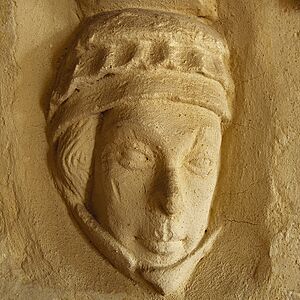
Two famous legends are told about Isabel de Forz.
One story, called the Seven Crosses, has many versions. It says that Isabel met a poor man carrying a basket. He claimed it held puppies, but it was actually his seven children. He was going to drown them because he couldn't afford to feed them. Isabel was very upset by this. She adopted the children, made sure they were cared for and well-educated, and found jobs for them when they grew up.
The other legend is about a disagreement over the border of four parishes in East Devon. Isabel, as the Countess of Devon, was asked to help settle the dispute. The story says she met the people involved on a marshy hill. She took a ring off her finger and threw it into the middle of the bog, declaring, "that shall be the boundary!" The place where these four parishes meet is now called "Ring in the Mire."
Isabel is also said to have given a permanent water supply to the people of Tiverton, Devon. A special ceremony, called the Perambulation of the Town Leat, still takes place in the town every seven years to remember this gift. There was also a tradition that she was responsible for planting Wistman's Wood, a group of old, small oak trees high up on Dartmoor.
Images for kids


